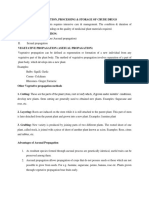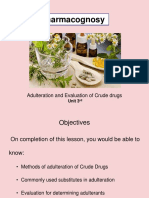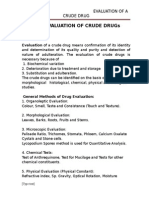0%(1)0% found this document useful (1 vote)
549 viewsDifferent Species
Different Species
Uploaded by
Archana PawarThe document compares two plant species: Digitalis Purpurea and Digitalis Lanata. It notes their microscopic and macroscopic differences, including that Digitalis Purpurea has single-layered palisade cells while Digitalis Lanata has double-layered palisade cells. It also compares their epidermal cell structures, trichome structures, distributions, and inflorescence structures. The document then compares several other pairs of plant species, noting their synonyms, biological sources, chemical constituents, uses, and microscopic and macroscopic differences between each pair.
Copyright:
© All Rights Reserved
Available Formats
Download as PDF, TXT or read online from Scribd
Different Species
Different Species
Uploaded by
Archana Pawar0%(1)0% found this document useful (1 vote)
549 views16 pagesThe document compares two plant species: Digitalis Purpurea and Digitalis Lanata. It notes their microscopic and macroscopic differences, including that Digitalis Purpurea has single-layered palisade cells while Digitalis Lanata has double-layered palisade cells. It also compares their epidermal cell structures, trichome structures, distributions, and inflorescence structures. The document then compares several other pairs of plant species, noting their synonyms, biological sources, chemical constituents, uses, and microscopic and macroscopic differences between each pair.
Original Description:
Important notes
Original Title
Different species
Copyright
© © All Rights Reserved
Available Formats
PDF, TXT or read online from Scribd
Share this document
Did you find this document useful?
Is this content inappropriate?
The document compares two plant species: Digitalis Purpurea and Digitalis Lanata. It notes their microscopic and macroscopic differences, including that Digitalis Purpurea has single-layered palisade cells while Digitalis Lanata has double-layered palisade cells. It also compares their epidermal cell structures, trichome structures, distributions, and inflorescence structures. The document then compares several other pairs of plant species, noting their synonyms, biological sources, chemical constituents, uses, and microscopic and macroscopic differences between each pair.
Copyright:
© All Rights Reserved
Available Formats
Download as PDF, TXT or read online from Scribd
Download as pdf or txt
0%(1)0% found this document useful (1 vote)
549 views16 pagesDifferent Species
Different Species
Uploaded by
Archana PawarThe document compares two plant species: Digitalis Purpurea and Digitalis Lanata. It notes their microscopic and macroscopic differences, including that Digitalis Purpurea has single-layered palisade cells while Digitalis Lanata has double-layered palisade cells. It also compares their epidermal cell structures, trichome structures, distributions, and inflorescence structures. The document then compares several other pairs of plant species, noting their synonyms, biological sources, chemical constituents, uses, and microscopic and macroscopic differences between each pair.
Copyright:
© All Rights Reserved
Available Formats
Download as PDF, TXT or read online from Scribd
Download as pdf or txt
You are on page 1of 16
Identification and Significance of
morphology and microscopically
Difference between Plants of
allied species
Mrs. Nilofar A. Khan
Digitalis Prupurea Digitalis lanata
Digitalis Purpurea Digitalis Lanata
Microscopic
Palisade Single layered Palisade Double layered
Epidermal cells polygonal, wavy Epidermal cells beaded, wavy
walled walled
Covering trichome uniseriate, Covering trichome uniseriate,
multicellular(3-5-7 celled) multicellular(2-10 celled)
Distribution
Biennial or perennial perennial
Macroscopic
Inflorescence: Long and Unilateral Inflorescence: Long and dense
raceme raceme
Flower: Purple Flower: White
Leaves Leaves
Brahmi Jalbrahmi
Synonym: Bacopa Synonym: Gotu Kola,Madukparni,
Centella
Biological Source: Bacopa Biological Source: Centella
Moniera asiatica
Family Scrophulariaceae Family Umbelliferae
Chemical Constituents: Chemical Constituents
Brahmine, hespestine, Asiaticoside and madecassoside,
Bacosides A &B bramhmoside, brahinoside
Use: Nervine Tonic, Use: Nervine Tonic, Shows
Treatment asthama, sedative, spasmolytic activity
epilepsy
Brahmi Jalbrahmi
Macroscopic
Leaf Leaf
Shape: Obovate Shape: Orbicular
Apex Acuminate Apex :----
Base: Symmetric Base: Symmetric
Margin : Straight Margin : Denate, Crenate
Petioles: Sessile(no petioles) Petioles: Longer and bigger
Flower: Solitary,Stalked, Flower: Pink sessile flower
corolla bluish white
Inflorescence: No Inflorescence: Umbel
Microscopic
Stomata: Anomocytic Stomata: Diacytic
Trichome: very few ,sessile Trichome: not visible
Cinnamon Cassia Cinnamon
Synonym: Kalmi- Dalchini, Synonym: Dalchini, Chinese
Ceyon Cinnamon cinnamon
Biological Source: Biological Source: Cinnamomum
Cinnamomum Zeylanicum cassia ,Family: Lauraceae
Family : Lauraceae
Chemical Constituents: Chemical Constituents: NLT
Contains 60-70% cinnamic 85% cinnamic aldehyde and very
aldehyde and 5-10%, small amount eugenol. also
eugenol, also contain sweet contain cinnamyl acetate,
substance know as mannitol, coumarin
Benzaldehyde,
cuminaldehyde, pinene etc
Use:Carminative, Stimulant, Use: Carminative, Stimulant,
flavouring agent and mild flavouring agent
Cinnamon Cassia Cinnamon
Macroscopic
Colour: The outer surface is Colour:. Dirty brown
dull yellow-brown, while the
inner surface is dark
yellowish brown.
Odour: Fragrant Odour: Characteristic, sweet,
aromatic
Shape: Compound quill or Shape: Single quill or channelled
single or double quill piece
Taste: Aromatic and sweet Taste: Aromatic , slightly sweet
followed by warm sensation and mucilagenous
Fracture: Splintery Fracture: Slightly fibrous
Microscopic
Tinospora Chinese Tinospora
Synonym: Guduchi , Gulvel, Synonym: Malabar gulbel,
Amrita
Biological Source: Biological Source: Tinospora
Tinospora cordifolia sinesis Family :
Family : Menispermaeceae Menispermaeceae
Chemical Constituents: It Chemical Constituents: A
consist of tinosporine, ditereperne glycosides
tinosporic acid, tinosposinensides A-C(1-3) and
tinosporidine, Cordifolioside a new rearranged cadinane
A etc sesquiterpene glycoside
tinosinenside and phenolic
glycoside tinosinen was isolated
from fresh stems
Tinospora Chinese Tinospora
Macroscopic
Leaves: Leaves:
Shape: Broadly ovate or Shape: Broadly ovate
ovate cordate Apex: acuminate
Apex: acuminate Base: cordate
Base: deep cordate
Inflorescence: Terminal Inflorescence: Racemes
Racemes
Fruits: aggregate, orange Fruits: cluster, orange- red when
when ripped ripped
Flower: greenish yellow Flower: greenish yellow.
Male flower in cluster and Male and female flowers are
female flower solitary seen separately in the same plant
Stem: Stem:
Tinospora Chinese Tinospora
You might also like
- Advance Herbal Technology PPT 1Document15 pagesAdvance Herbal Technology PPT 1satoshiNo ratings yet
- VIJAY 5G Front Comms Net 2021Document8 pagesVIJAY 5G Front Comms Net 2021David IbanezNo ratings yet
- Introductory Biochemistry Midterm ExamDocument10 pagesIntroductory Biochemistry Midterm ExamZachary McCoyNo ratings yet
- CULTIVATION, COLLECTION, PROCESSING AND STORAGE OF CRUDE DRUGS OF NATURAL ORIGIN-converted-1Document9 pagesCULTIVATION, COLLECTION, PROCESSING AND STORAGE OF CRUDE DRUGS OF NATURAL ORIGIN-converted-1AMINA FAREEZANo ratings yet
- Introduction To Phytochemistry and Tannins-1Document35 pagesIntroduction To Phytochemistry and Tannins-1Boas WayneNo ratings yet
- 1 - 2 Introduction of Phytochemisry IDocument20 pages1 - 2 Introduction of Phytochemisry IZNA EntertainmentNo ratings yet
- Blood Product and Plasma SubstituentsDocument14 pagesBlood Product and Plasma SubstituentsDivya KMNo ratings yet
- Pharmacognocy Notes (ASCP) - 2Document157 pagesPharmacognocy Notes (ASCP) - 2ASCP WestwoodNo ratings yet
- Factors Affecting CultivationDocument20 pagesFactors Affecting CultivationNishamolKSNo ratings yet
- Classification of Crude Drugs by Dr.U.Srinivasa, Professor and Head, Srinivas College of Pharmacy, Mangalore - 574143, KarnatakaDocument30 pagesClassification of Crude Drugs by Dr.U.Srinivasa, Professor and Head, Srinivas College of Pharmacy, Mangalore - 574143, KarnatakaDR.U.SrinivasaNo ratings yet
- PODOPHYLLUMDocument5 pagesPODOPHYLLUMHarish Kakrani100% (1)
- GIT DrugsDocument57 pagesGIT Drugssalva sambaaNo ratings yet
- Manual For PrintDocument59 pagesManual For PrintShweta BhutadaNo ratings yet
- Methods of AdultrationDocument3 pagesMethods of Adultrationdrprambabu2011100% (1)
- Adulteration of Drugs by Dr.U.Srinivasa, Professor and HOD, Srinivas College of Pharmacy, Mangalore, IndiaDocument30 pagesAdulteration of Drugs by Dr.U.Srinivasa, Professor and HOD, Srinivas College of Pharmacy, Mangalore, IndiaDR.U.SrinivasaNo ratings yet
- Dpharma 1 Year Pharmacognosy 2603 Jul 2022Document9 pagesDpharma 1 Year Pharmacognosy 2603 Jul 2022rjanimalkingdom1No ratings yet
- Herbal Drug Technology Typed - 1Document7 pagesHerbal Drug Technology Typed - 1Sri SriNo ratings yet
- Classification of Crude DrugsDocument18 pagesClassification of Crude Drugsasma nizamNo ratings yet
- 4) Organised and Unorganised Crude DrugsDocument26 pages4) Organised and Unorganised Crude DrugsAnuj DesaiNo ratings yet
- Lab Manual BP207PDocument31 pagesLab Manual BP207PCc12 22tNo ratings yet
- Unit 5 MicrobiologyDocument66 pagesUnit 5 Microbiologykrishkodal0020No ratings yet
- Evaluation of Crude DrugsDocument24 pagesEvaluation of Crude DrugsRojaNo ratings yet
- Study of Method of Section Cutting TechniqueDocument18 pagesStudy of Method of Section Cutting Techniquezero contentNo ratings yet
- Pharmacognosy NotesDocument2 pagesPharmacognosy NotesRishabhNo ratings yet
- Pharmacognosy Chapter 7 Traditional System of Medicine Ayurvedic Preparations NotesDocument13 pagesPharmacognosy Chapter 7 Traditional System of Medicine Ayurvedic Preparations NotesAbhishek palNo ratings yet
- REPORT 8th SEMDocument39 pagesREPORT 8th SEMDIPENDRASINH SOLANKINo ratings yet
- Chapter 4 Pharmacognosy Complete Notes by Noteskarts Acc To ER20Document16 pagesChapter 4 Pharmacognosy Complete Notes by Noteskarts Acc To ER20Hannan MariyamNo ratings yet
- Filtration For Pharmaceutics D Pharm 1st YearDocument5 pagesFiltration For Pharmaceutics D Pharm 1st Yeargahirhari383No ratings yet
- Adulteration and Evaluation of Crude DrugsDocument48 pagesAdulteration and Evaluation of Crude DrugsVikash KushwahaNo ratings yet
- Crude Drugs and Their ClassificationDocument8 pagesCrude Drugs and Their Classificationmueen hashmi100% (1)
- HDT Practical BATCH-I Question PaperDocument2 pagesHDT Practical BATCH-I Question PaperjyothipasamNo ratings yet
- Sterile Products & ParenteralsDocument41 pagesSterile Products & ParenteralsRonit PoudelNo ratings yet
- 11-Herbal Drugs IndustryDocument10 pages11-Herbal Drugs IndustryMamta PantNo ratings yet
- Evaluation of Crude DrugsDocument13 pagesEvaluation of Crude DrugsPalakshVismayNo ratings yet
- All Synthesis of Medichem-3 For 6th Semester of B.pharmaDocument18 pagesAll Synthesis of Medichem-3 For 6th Semester of B.pharmaTechnical PharmaNo ratings yet
- Orientation To Pharmacy: Al-Ain University of Science and Technology College of Pharmacy Part 2Document32 pagesOrientation To Pharmacy: Al-Ain University of Science and Technology College of Pharmacy Part 2Khairi Mustafa SalemNo ratings yet
- Evaluation of A Crude Drug FullDocument10 pagesEvaluation of A Crude Drug Fulltarkeesantosh100% (1)
- Amla Preserve and CandyDocument2 pagesAmla Preserve and CandySathyendra RaoNo ratings yet
- Pharmacognosy Assignment StarchDocument3 pagesPharmacognosy Assignment StarchAbdul BasitNo ratings yet
- Experimental Review On Pharmacognosy LabDocument10 pagesExperimental Review On Pharmacognosy LabsheatNo ratings yet
- Unit-3 HDTDocument15 pagesUnit-3 HDTAbhishek BhosaleNo ratings yet
- GlycosidesDocument28 pagesGlycosidesApple Jane F. Bartolome100% (2)
- Isolation Identification and Analysis of PhytoconstituentsDocument30 pagesIsolation Identification and Analysis of PhytoconstituentsMurugan MNo ratings yet
- Pharmacognosy Lab Manual PDFDocument53 pagesPharmacognosy Lab Manual PDFKaustubh KapadnisNo ratings yet
- Phytochemistry PDFDocument68 pagesPhytochemistry PDFTrixia Marix BunglayNo ratings yet
- Adulteration of Crude DrugDocument40 pagesAdulteration of Crude DrugGhanshyam R. Parmar100% (6)
- Lecture 5 Bioassay of InsulineDocument12 pagesLecture 5 Bioassay of Insulinem ahsanNo ratings yet
- Topics: CLASS No. - 1 (B. Pharm. 4 Sem, Pharmacology) by Dr. Habibur RahmanDocument4 pagesTopics: CLASS No. - 1 (B. Pharm. 4 Sem, Pharmacology) by Dr. Habibur RahmanHabibur RahmanNo ratings yet
- Dispensing PracticeDocument86 pagesDispensing PracticeVon Valentine MhuteNo ratings yet
- Biopharmaceutics Unit 4Document19 pagesBiopharmaceutics Unit 4Niki Rokade DahaleNo ratings yet
- Lecture Notes: Pharmacognosy AND Phytochemistry Ii - Theory (Bp504 T) (Unit-Iii)Document30 pagesLecture Notes: Pharmacognosy AND Phytochemistry Ii - Theory (Bp504 T) (Unit-Iii)Rinki MehtaNo ratings yet
- Compounding in Hospitals (Hospital & Clinical Pharmacy)Document26 pagesCompounding in Hospitals (Hospital & Clinical Pharmacy)117 Komal SatheNo ratings yet
- Final Quality ControlDocument36 pagesFinal Quality ControlRajeswari Rajarammurthy R100% (1)
- Traditional System of Medicine Chpter 6Document25 pagesTraditional System of Medicine Chpter 6SagarpharnacyNo ratings yet
- Adulteration of Crude DrugsDocument31 pagesAdulteration of Crude DrugsParajapati SanjivNo ratings yet
- PT-412 U-II Cultivation, Collection, Factors...Document6 pagesPT-412 U-II Cultivation, Collection, Factors...nemocNo ratings yet
- 2 Pharmacognosy 416 Animal Drugs Honey GelatinDocument10 pages2 Pharmacognosy 416 Animal Drugs Honey GelatintiaraNo ratings yet
- Herbal Drug TechnologyDocument2 pagesHerbal Drug TechnologyHrishikesh Patil0% (2)
- Causes of NonlinearityDocument3 pagesCauses of NonlinearityHritik ChaubeyNo ratings yet
- Scope of PharmacognosyDocument6 pagesScope of PharmacognosyDr. Mussadiq Latif88% (16)
- O Level MCQ Test On Digestive SystemDocument2 pagesO Level MCQ Test On Digestive SystemKS CoachingNo ratings yet
- 3M Scotchkote 14853 Electrical Coating FDDocument16 pages3M Scotchkote 14853 Electrical Coating FDempmedicNo ratings yet
- Nbme 24 Explanations - Annotation SummaryDocument55 pagesNbme 24 Explanations - Annotation Summarynaazaninrahat76No ratings yet
- Wallstreetjournal 20230728 TheWallStreetJournalDocument40 pagesWallstreetjournal 20230728 TheWallStreetJournalflorin suteuNo ratings yet
- R138911 Amit Kumar 300822180312Document3 pagesR138911 Amit Kumar 300822180312amit kumarNo ratings yet
- Cellu Coelenterata Cnldarla) : L e V C L - J o R I F e R ADocument9 pagesCellu Coelenterata Cnldarla) : L e V C L - J o R I F e R AThe Dream HackerNo ratings yet
- G 4Document20 pagesG 4wedajeNo ratings yet
- BCECE 2014 Biology Question PaperDocument11 pagesBCECE 2014 Biology Question PaperAnweshaBose67% (12)
- Micro-10-QA-002 (1) (1)Document13 pagesMicro-10-QA-002 (1) (1)Tahir IbrahimNo ratings yet
- ECOLOGY TEST Mhs JusanDocument4 pagesECOLOGY TEST Mhs Jusannatukundajoshua42No ratings yet
- 3.3 Meiosis Interactive Story - GuidanceDocument9 pages3.3 Meiosis Interactive Story - GuidancettNo ratings yet
- Evaluation of Effect of Smoking and Hypertension On Serum Lipid Profile and Oxidative StressDocument3 pagesEvaluation of Effect of Smoking and Hypertension On Serum Lipid Profile and Oxidative StressAan AchmadNo ratings yet
- Project On Botanical ExtractDocument11 pagesProject On Botanical Extractmogreshikha73No ratings yet
- The Evolution of The Upright Posture and Gait-A ReviewDocument23 pagesThe Evolution of The Upright Posture and Gait-A ReviewRicardo Filipe Afonso MangeronaNo ratings yet
- Wastewater Treatment BlanksDocument17 pagesWastewater Treatment BlanksHRK65No ratings yet
- Lesson 5 - Cell ModificationDocument3 pagesLesson 5 - Cell ModificationEarl Caesar Quiba Pagunsan100% (2)
- Panjab University: RD THDocument44 pagesPanjab University: RD THgobar dassNo ratings yet
- Kunz Et Al. - 1996 - High-pH Anion-Exchange Chromatography With PulsedDocument11 pagesKunz Et Al. - 1996 - High-pH Anion-Exchange Chromatography With PulsedValerie WeinbornNo ratings yet
- Kingdom Prokaryotae (Monera) : Short Questions AnswersDocument6 pagesKingdom Prokaryotae (Monera) : Short Questions AnswersNadeem ArainNo ratings yet
- TRENDS Module 8Document28 pagesTRENDS Module 8Jearim MalicdemNo ratings yet
- MC 2L Act. 4 Isolation Characterization of Nucleic AcidsDocument5 pagesMC 2L Act. 4 Isolation Characterization of Nucleic AcidsRyan Carlo IbayanNo ratings yet
- Psychology of Patanjali Yoga Sutras - FinalDocument7 pagesPsychology of Patanjali Yoga Sutras - Finalsmitha.jasti100% (1)
- Traits AlportDocument182 pagesTraits AlportvivaldiozNo ratings yet
- Canadian Criminology Today Theories and Applications Canadian 5th Edition Schmalleger Solutions Manual 1Document36 pagesCanadian Criminology Today Theories and Applications Canadian 5th Edition Schmalleger Solutions Manual 1kimberlyhortonfepbyjwzdr100% (35)
- Photosynthesis QuestionsDocument23 pagesPhotosynthesis Questionssheenaa100% (1)
- Quiz - EcosystemDocument2 pagesQuiz - Ecosystemnathan casinaoNo ratings yet
- Polymers 13 01989Document26 pagesPolymers 13 01989msorianolNo ratings yet
- 4392-Article Text-14095-1-10-20150624Document15 pages4392-Article Text-14095-1-10-20150624dewirrdNo ratings yet

























































































